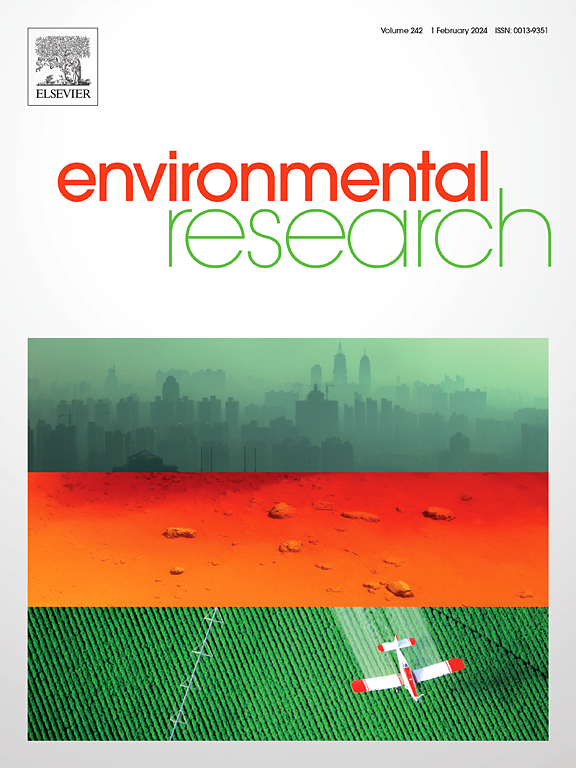Responses of coastal phytoplankton communities to herbicide exposure: enhanced resistance coupled with reduced resilience
IF 7.7
2区 环境科学与生态学
Q1 ENVIRONMENTAL SCIENCES
引用次数: 0
Abstract
Coastal ecosystems face increasing anthropogenic disturbances, making the survival strategies of phytoplankton communities under stress a critical issue in marine ecology. The community rescue theory suggests that exposure history can enhance phytoplankton's ability to withstand lethal stress, though the mechanisms remain unclear. This study utilized two-phase mesocosm experiments to simulate exposure history and lethal pressures. By combining tolerance and heritability tests, the mechanisms by which exposure history enhanced phytoplankton tolerance were investigated. The results demonstrated that: (1) Exposure history enhanced the community tolerance threshold to atrazine through ecological (the relative abundance of dinoflagellates increased by 13.6–66.4 %) and plastic processes (the EC50 of sensitive populations increased by 12.3–114.9 %). And this enhancement was positively correlated with exposure intensity but accompanied by suppression of community biomass. (2) Rescue was more likely to occur in large-scale communities, suggesting that high biomass was a prerequisite for populations/communities to survive the period of biomass collapse. Our findings aligned with the observation in in situ marine environments: long-term exposure to herbicides enhanced community tolerance (EC50 from 97.19 ± 6.8 nmol L−1 to 115.5 ± 7.8 nmol L−1) and delayed the collapse of communities under lethal pressure. However, this acquired tolerance was not heritable, and rescue still led to the loss of nearly half of rare taxa, potentially hindering the community's ability to withstand other environmental stressors. Our findings elucidate how phytoplankton communities achieve rescue through structural reorganization, providing crucial theoretical underpinnings for disturbance assessment in coastal ecosystems.

沿海浮游植物群落对除草剂暴露的反应:抗性增强,适应力降低
海岸带生态系统面临日益严重的人为干扰,浮游植物群落在胁迫下的生存策略成为海洋生态学研究的重要课题。社区救援理论认为,暴露历史可以增强浮游植物抵御致命压力的能力,尽管其机制尚不清楚。本研究采用两阶段中观实验模拟暴露史和致死压力。通过耐受性试验和遗传力试验相结合,探讨了暴露史增强浮游植物耐受性的机制。结果表明:(1)暴露史通过生态过程(鞭毛藻相对丰度增加13.6% ~ 66.4%)和塑料过程(敏感种群EC50增加12.3 ~ 114.9%)提高了种群对阿特拉津的耐受阈值。这种增强与暴露强度呈正相关,但同时伴随着群落生物量的抑制。(2)大规模群落更容易发生救援,表明高生物量是种群/群落在生物量崩溃期生存的先决条件。我们的研究结果与原位海洋环境的观察结果一致:长期暴露于除草剂增强了群落的耐受性(EC50从97.19±6.8 nmol L−1增加到115.5±7.8 nmol L−1),并延缓了群落在致死压力下的崩溃。然而,这种获得性的耐受性并不是遗传的,救援仍然导致了近一半的稀有分类群的损失,潜在地阻碍了群落抵御其他环境压力的能力。我们的研究结果阐明了浮游植物群落如何通过结构重组实现拯救,为沿海生态系统的干扰评估提供了重要的理论基础。
本文章由计算机程序翻译,如有差异,请以英文原文为准。
求助全文
约1分钟内获得全文
求助全文
来源期刊

Environmental Research
环境科学-公共卫生、环境卫生与职业卫生
CiteScore
12.60
自引率
8.40%
发文量
2480
审稿时长
4.7 months
期刊介绍:
The Environmental Research journal presents a broad range of interdisciplinary research, focused on addressing worldwide environmental concerns and featuring innovative findings. Our publication strives to explore relevant anthropogenic issues across various environmental sectors, showcasing practical applications in real-life settings.
 求助内容:
求助内容: 应助结果提醒方式:
应助结果提醒方式:


